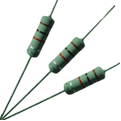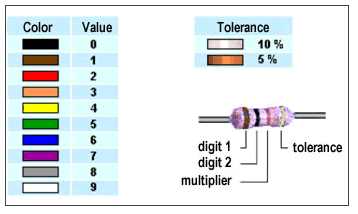Characteristics of resistors
A resistor is an electrical component that has two poles or terminals that enable to be inserted in a circuit to provide some restriction to the electrical current as it flows through. A resistor is also a symmetrical or takes the form of a linear dipole. Symmetrical means that its functioning does not depend on the direction in which it is connected, as the polarity can be inverted, producing the same effect in the circuit in which it is inserted. Linear means that Ohm's law works for it.
A resistor may consist of a long metal wire made of a material that is not excessively conductive, coiled up on a dielectric. This type was used for years, although ceramic resistors are commonly used nowadays.

Ceramic resistors
These resistors are built by placing an extremely thin layer of graphite on an insulating material and covering them with a coat of insulating paint. The coloured rings are painted on it and a code of colours that correspond to digits from 0 to 9 determine their value.

It is a link to a video that shows how resistors are identified: http://www.youtube.com/watch?v=I0K6ai9ZEbI [EN]
Resistor colour code calculator: http://www.hobby-hour.com/electronics/resistorcalculator.php